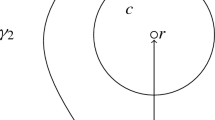Abstract
The Church-Turing thesis makes a bold claim about the theoretical limits to computation. It is based upon independent analyses of the general notion of an effective procedure proposed by Alan Turing and Alonzo Church in the 1930's. As originally construed, the thesis applied only to the number theoretic functions; it amounted to the claim that there were no number theoretic functions which couldn't be computed by a Turing machine but could be computed by means of some other kind of effective procedure. Since that time, however, other interpretations of the thesis have appeared in the literature. In this paper I identify three domains of application which have been claimed for the thesis: (1) the number theoretic functions; (2) all functions; (3) mental and/or physical phenomena. Subsequently, I provide an analysis of our intuitive concept of a procedure which, unlike Turing's, is based upon ordinary, everyday procedures such as recipes, directions and methods; I call them “mundane procedures.” I argue that mundane procedures can be said to be effective in the same sense in which Turing machine procedures can be said to be effective. I also argue that mundane procedures differ from Turing machine procedures in a fundamental way, viz., the former, but not the latter, generate causal processes. I apply my analysis to all three of the above mentioned interpretations of the Church-Turing thesis, arguing that the thesis is (i) clearly false under interpretation (3), (ii) false in at least some possible worlds (perhaps even in the actual world) under interpretation (2), and (iii) very much open to question under interpretation (1).
Similar content being viewed by others
References
Bennett, Charles (1988), ‘Logical Dept and Physical Complexity’, in R. Herkin, ed.,The Universal Turing Machine: A Half-Century Survey, Oxford: Oxford University Press, pp. 227–258.
Brand, Myles (1976),The Nature of Causation, Chicago: University of Illinois Press.
Child, Julia (1961),Mastering the Art of French Cooking, New York: Knopf.
Chisholm, Roderick (1955), ‘Law Statements and Counterfactual Inference’,Analysis 15, pp. 97–105.
Church, Alonzo (1934), ‘The Richard Paradox’,American Mathematical Monthly 41, pp. 356–361.
Church, Alonzo (1965), ‘An Unsolvable Problem of Elementary Number Theory’, in M. Davis, ed.,The Undecidable, New York: Raven Press, pp. 88–107.
Churchland, Paul and Patricia (1990), ‘Stalking the Wild Epistemic Engine’, in W. Lycan, ed.,Mind and Cognition, Cambridge: Basil Blackwell.
Cleland, Carol (1985), ‘Causality, Chance and Weak Non-Supervenience’,American Philosophical Quarterly 22, pp. 287–298.
Cleland, Carol (1990), ‘The Difference Between Real Change andMere Cambridge Change’,Philosophical Studies 60, pp. 247–278.
Cleland, Carol (forthcoming), ‘Events, Actions and Mere Happenings’.
Finkelstein, David (1988), ‘Finite Physics’, in R. Herkin, ed.,The Universal Turing Machine: A Half-Century Survey, Oxford: Oxford University Press, pp. 349–376.
Geroch, Robert & Hartle, James (1986), ‘Computability and Physical Theories’,Foundations of Physics 16, pp. 533–548.
Goldman, Alvin (1970),A Theory of Human Action, Princeton: Princeton University Press.
Hamlet, Richard (1974),Introduction to Computing Theory, New York: Intext.
Harre, Rom (1970),Principles of Scientific Thinking, Chicago: UNiversity of Chicago Press.
Hofstadter, Douglas (1980),Gödel, Escher, Bach, New York: Random House.
Hofstadter, Douglas (1981), ‘A Conversation with Einstein's Brain’, in D. Hofstadter & D. Dennett, eds.,The Kind's I, New York: Basic Books, pp. 439–446.
Hume, David (1975), “Treatise of Human Nature (Bk. I, Pt. III, Sec. XIV)’, in Selby-Bigge, ed.,Hume's Treatise of Human Nature, Oxford: Oxford University Press, pp. 155–172.
Kim, Jaegwon (1980), ‘Causes and Counterfactuals’, in E. Sosa,Causation and Conditionals, Oxford: Oxford University Press, pp. 192–194.
Kleene, Steven (1936), ‘Definability and Recursiveness”,Duke Mathematical Journal 2, pp. 340–353.
Kleene, Steven (1988), ‘Turing's Analysis of Computability, and Major Applications of It’, in R. Herkin, ed.,The Universal Turing Machine: A Half-Century Survey, Oxford: Oxford University Press, pp. 17–54.
Minsky, Marvin (1967),Computation: Finite and Infinite Machines, Englewood Cliffs: Prentice-Hall.
Nelson, R. J. (1988), ‘Connections Among Connections’,Behavioral and Brain Sciences 11, pp. 45–46.
Penrose, Roger (198), ‘On the Physics and Mathematics of Thought’, in R. Herkin, ed.,The Universal Turing Machine: A Half-Century Survey, Oxford: Oxford University Press, pp. 491–522.
Penrose, Roger (1990),The Emperor's New Mind, Oxford: Oxford University Press.
Reichenbach, Hans (1956),The Direction of Time, Berkeley: University of California Press.
Rosen, Robert (1988), ‘Effective Processes and Natural Law’, in R. Herkin, ed.,The Universal Turing Machine: A Half-Century Survey, Oxford: Oxford University Press, pp. 523–537.
Rubel, Lee A. (1989), ‘Digital Simulation of Analog Computation and Church's Thesis’,Journal of Symbolic Logic 54, pp. 1011–1017.
Searle, John (1985), ‘Minds, Brains and Programs’, in Haugeland, ed.,Mind Design. Cambridge: The MIT Press.
Shapiro, Stewart (1981), ‘Understanding Church's Thesis’,Journal of Philosophical Logic 10, pp. 352–365.
Smolensky, Paul (1988), ‘The Proper Treatment of Connectionism’,Behavioral and Brain Sciences 11, pp. 1–23.
Turing, Alan, (1937), ‘Computability and λ-definability’,Journal of Symbolic Logic 2, pp. 153–163.
Turing, Alan (1964), ‘Computing Machinery and Intelligence’, in A. Anderson, ed.,Minds and Machines, New Jersey: Prentice Hall, pp. 4–30.
Turing, Alan (1965), ‘On Computable Numbers, With an Application to theEntscheidungs Problem’, in M. Davis, ed.,The Undecidable, New York: Raven Press, pp. 116–154.
von Neumann, J. (1966),Theory of Self-Reproducing Automata. Urbana: University of Illinois Press.
Weizenbaum, Joseph (1986),Computer Power and Human Reason, San Francisco: Freedman & Co.
Author information
Authors and Affiliations
Rights and permissions
About this article
Cite this article
Cleland, C.E. Is the Church-Turing thesis true?. Mind Mach 3, 283–312 (1993). https://doi.org/10.1007/BF00976283
Issue Date:
DOI: https://doi.org/10.1007/BF00976283




